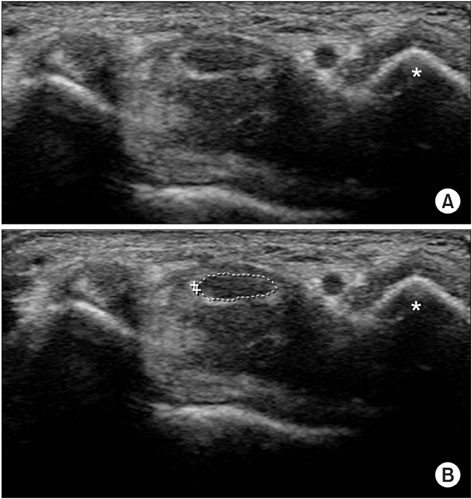Clin Orthop Surg.
2016 Sep;8(3):298-302. 10.4055/cios.2016.8.3.298.
Changes in Clinical Symptoms, Functions, and the Median Nerve Cross-Sectional Area at the Carpal Tunnel Inlet after Open Carpal Tunnel Release
- Affiliations
-
- 1Department of Orthopedic Surgery, Ewha Womans University Mokdong Hospital, Ewha Womans University School of Medicine, Seoul, Korea. kimjk@ewha.ac.kr
- KMID: 2374276
- DOI: http://doi.org/10.4055/cios.2016.8.3.298
Abstract
- BACKGROUND
The aim of this study was to investigate the relationship between clinical symptoms and cross-sectional area (CSA) of the median nerve at the carpal tunnel inlet before and after open carpal tunnel release (CTR).
METHODS
Thirty-two patients (53 hands) that underwent open CTR for idiopathic carpal tunnel syndrome were prospectively enrolled. Median nerve CSA at the carpal tunnel inlet was measured preoperatively and at 2 and 12 weeks after CTR by high resolution ultrasonography. The Boston carpal tunnel questionnaire (BCTQ) was also completed at these times.
RESULTS
BCTQ symptom (BCTQ-S) score was significantly improved at 2 weeks postoperatively, but BCTQ function (BCTQ-F) score and CSA were significantly improved at 12 weeks postoperatively. Preoperative CSA was significantly correlated with preoperative BCTQ-S and BCTQ-F scores but was not significantly correlated with postoperative BCTQ scores or postoperative changes in BCTQ scores. Postoperative median nerve CSA was not significantly correlated with postoperative BCTQ-S or BCTQ-F scores, and postoperative changes in median nerve CSA were not significantly correlated with postoperative changes in BCTQ-S or BCTQ-F scores.
CONCLUSIONS
The study shows clinical symptoms resolve rapidly after open CTR, but median nerve swelling and clinical function take several months to recover. In addition, preoperative median nerve swelling might predict preoperative severities of clinical symptoms and functional disabilities. However, postoperative reductions in median nerve swelling were not found to reflect postoperative reductions in clinical symptoms or functional disabilities.
MeSH Terms
-
Anatomy, Cross-Sectional
Carpal Tunnel Syndrome/diagnostic imaging/epidemiology/*physiopathology/*surgery
Female
Humans
Male
Median Nerve/anatomy & histology/physiopathology/*surgery
Middle Aged
Orthopedic Procedures/*statistics & numerical data
Prospective Studies
Surveys and Questionnaires
Ultrasonography
Wrist/surgery
Figure
Cited by 2 articles
-
Effects of a Temperature-sensitive, Anti-adhesive Agent on the Clinical Outcome of Carpal Tunnel Release Surgery
Soo Min Cha, Hyun Dae Shin
Arch Hand Microsurg. 2018;23(2):126-137. doi: 10.12790/ahm.2018.23.2.126.The prognostic value of median nerve thickness in diagnosing carpal tunnel syndrome using magnetic resonance imaging: a pilot study
Sooho Lee, Hyung Rae Cho, Jun Sung Yoo, Young Uk Kim
Korean J Pain. 2020;33(1):54-59. doi: 10.3344/kjp.2020.33.1.54.
Reference
-
1. Hobson-Webb LD, Massey JM, Juel VC, Sanders DB. The ultrasonographic wrist-to-forearm median nerve area ratio in carpal tunnel syndrome. Clin Neurophysiol. 2008; 119(6):1353–1357.
Article2. Wiesler ER, Chloros GD, Cartwright MS, Smith BP, Rushing J, Walker FO. The use of diagnostic ultrasound in carpal tunnel syndrome. J Hand Surg Am. 2006; 31(5):726–732.
Article3. Buchberger W, Schon G, Strasser K, Jungwirth W. High-resolution ultrasonography of the carpal tunnel. J Ultrasound Med. 1991; 10(10):531–537.
Article4. Yesildag A, Kutluhan S, Sengul N, et al. The role of ultrasonographic measurements of the median nerve in the diagnosis of carpal tunnel syndrome. Clin Radiol. 2004; 59(10):910–915.
Article5. Vogelin E, Nuesch E, Juni P, Reichenbach S, Eser P, Ziswiler HR. Sonographic follow-up of patients with carpal tunnel syndrome undergoing surgical or nonsurgical treatment: prospective cohort study. J Hand Surg Am. 2010; 35(9):1401–1409.
Article6. Kaymak B, Ozcakar L, Cetin A, Candan Cetin M, Akinci A, Hascelik Z. A comparison of the benefits of sonography and electrophysiologic measurements as predictors of symptom severity and functional status in patients with carpal tunnel syndrome. Arch Phys Med Rehabil. 2008; 89(4):743–748.
Article7. Karadag YS, Karadag O, Cicekli E, et al. Severity of Carpal tunnel syndrome assessed with high frequency ultrasonography. Rheumatol Int. 2010; 30(6):761–765.
Article8. Tajika T, Kobayashi T, Yamamoto A, Kaneko T, Takagishi K. Diagnostic utility of sonography and correlation between sonographic and clinical findings in patients with carpal tunnel syndrome. J Ultrasound Med. 2013; 32(11):1987–1993.
Article9. Abicalaf CA, de Barros N, Sernik RA, et al. Ultrasound evaluation of patients with carpal tunnel syndrome before and after endoscopic release of the transverse carpal ligament. Clin Radiol. 2007; 62(9):891–894.
Article10. Colak A, Kutlay M, Pekkafali Z, et al. Use of sonography in carpal tunnel syndrome surgery: a prospective study. Neurol Med Chir (Tokyo). 2007; 47(3):109–115.11. Lee CH, Kim TK, Yoon ES, Dhong ES. Postoperative morphologic analysis of carpal tunnel syndrome using high-resolution ultrasonography. Ann Plast Surg. 2005; 54(2):143–146.
Article12. Mondelli M, Filippou G, Aretini A, Frediani B, Reale F. Ultrasonography before and after surgery in carpal tunnel syndrome and relationship with clinical and electrophysiological findings: a new outcome predictor? Scand J Rheumatol. 2008; 37(3):219–224.
Article13. Naranjo A, Ojeda S, Rua-Figueroa I, Garcia-Duque O, Fernandez-Palacios J, Carmona L. Limited value of ultrasound assessment in patients with poor outcome after carpal tunnel release surgery. Scand J Rheumatol. 2010; 39(5):409–412.
Article14. Smidt MH, Visser LH. Carpal tunnel syndrome: clinical and sonographic follow-up after surgery. Muscle Nerve. 2008; 38(2):987–991.
Article15. Cellocco P, Rossi C, Bizzarri F, Patrizio L, Costanzo G. Mini-open blind procedure versus limited open technique for carpal tunnel release: a 30-month follow-up study. J Hand Surg Am. 2005; 30(3):493–499.
Article16. Bromley GS. Minimal-incision open carpal tunnel decompression. J Hand Surg Am. 1994; 19(1):119–120.
Article17. Serra JM, Benito JR, Monner J. Carpal tunnel release with short incision. Plast Reconstr Surg. 1997; 99(1):129–135.
Article18. Kim JK, Lim HM. The Korean version of the Carpal Tunnel Questionnaire: cross cultural adaptation, reliability, validity and responsiveness. J Hand Surg Eur Vol. 2015; 40(2):200–205.
Article
- Full Text Links
- Actions
-
Cited
- CITED
-
- Close
- Share
- Similar articles
-
- RE: Value of Power Doppler and Gray-Scale US in the Diagnosis of Carpal Tunnel Syndrome: Contribution of Cross-Sectional Area just before the Tunnel Inlet as Compared with the Cross-Sectional Area at the Tunnel
- Clinical Results of Open versus Endoscopic Carpal Tunnel Release
- Ultrasonographic Study of Median Nerve after Carpal Tunnel Release
- Ulnar Neuropathy at the Wrist in a Patient with Carpal Tunnel Syndrome after Open Carpal Tunnel Release
- Revision Surgery after Carpal Tunnel Release for Idiopathic Carpal Tunnel Syndrome


